The Monks of LeBarroux Visit St. Mary's
by Mary E. Gentges with James S. Taylor
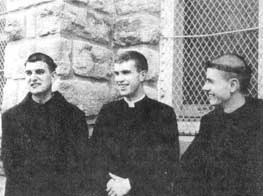
Benedictine Monks at Saint Mary's! With St. Mary's Rector, Father de la Tour, are Brother Cyprian (left) and Father Basil (on the right), of the traditional Benedictine Monastery of St. Madeleine, LeBarroux, France
The Seventh Annual St. Mary's Pilgrimage could be subtitled "A Visit from the Benedictine Monks of LeBarroux." Due to their presence, this year's Pilgrimage took on a monastic spirit and provided a deeply appreciated glimpse into the monastic life. For many—both young and old—it was their first opportunity to meet real monks. As one lady said with joy and awe, "The Church really is re-building!"
Our Pilgrimage guests, Father Basil and Brother Cyprian, are from the Monastery of St. Madeleine, near LeBarroux in the Provence region of southern France. Their monastery began in 1969 when Fr. Gerard Calvet—seeing where the post-Vatican II experimentation was leading—asked and received the blessing of his abbot to try an "experiment in tradition"! He settled in the abandoned 10th-century buildings of the Benedictine Priory of St. Madeleine—named for St. Mary Magdalene, Patroness of Provence. There he prayed for guidance, and in five days the first candidate knocked at the door—and they have been coming steadily ever since! From countries of Europe and North and South America they have come, proving that the desire to consecrate their lives to God and live the traditional monastic life is still alive in young souls in the modern world. Their life is centered around the Tridentine Latin Mass and the chant of the Divine Office seven times a day and once at night—the Opus Dei, or "work of God," for the monk.
For a year the people of St. Mary's had awaited the visit of the monks of LeBarroux, and they arrived at last on August 12, the feast of St. Clare.
Tuesday, August 13
A day of arrival and registration for the pilgrims, who could tour the College campus, visit the bookstore, or go to the air-conditioned "hospitality room" to enjoy refreshments and conversation with other pilgrims. Confessions were heard during the afternoon, and at 5:00 p.m. low Mass was celebrated for the pilgrims by Father Basil with Brother Cyprian serving.
The Benedictine character of the Pilgrimage was immediately evident for the vestments of the Benedictines are somewhat different from those of our Society of St. Pius X priests. Brother Cyprian served Mass wearing a long, white-hooded garment that corresponds to the white surplice worn by altar boys. For Father Basil, the same garment corresponds to the alb, and the hood to the amice. When a priest vests for Mass, he touches the amice to his head and asks to receive the "helmet of salvation" to resist the attacks of the devil. For the monk, this "helmet of salvation" is truly a head-covering. In place of the biretta (the black, four-cornered hat), the monk enters the sanctuary wearing the white hood, which is lowered before Mass begins, and rests on the priest's shoulders outside the chasuble.
Low Mass was followed by a get-acquainted dinner with welcome address by St. Mary's Rector, Father de la Tour. Then just at dark, the Stations of the Cross were said outdoors in the quadrangle where candles glowed in the grass at the foot of each of the fourteen large wooden crosses. As the cross-bearer and two acolytes stopped before each station, a light was beamed onto it while Fr. DeLallo led the prayers. The Stations concluded with the beautiful petition for God's mercy, the hymn Parce Domine.
Also, on the thirteenth, the monks gave a conference to the seven Benedictine "Oblates" of St. Mary's. Canonically the same as third order members, the Oblates are somewhat different in spirit according to James S. Taylor, spokesman for the Oblates at St. Mary's, who explains, "The lay Oblate is taken into the Benedictine family as a real family member, and linked in spirit to the monastery—a powerhouse of prayer."
Wednesday, The Vigil of the Assumption
At 6:00 a.m. the monks sang the office of Lauds with the St. Mary's Oblates and some pilgrims, and then priests began saying their morning Masses. To accommodate the priests present, the side altar in Assumption Chapel was in use, so that two Low Masses could be celebrated simultaneously—formerly a common practice in large Catholic establishments.
At St. Mary's, religious of the Society of St. Pius X generally chant three "hours" of the Divine Office—Prime, Sext and Compline—publicly each day. With the monks present, seven hours were chanted publicly! The bulletin board noted which hours would be according to "Benedictine Rite" or "Roman Rite." For those of us accustomed to hearing the Office chanted by religious of the Society, it was most interesting to observe in the Benedictine manner differences in the monastic tone, the much slower way of singing the Gloria Patri, and the profound bow accompanying it. We could imagine what it must be like to hear fifty monks in choir singing the praises of God!
At 8:00 a.m. Father Arnaud Devillers, recently ordained and assigned to St. Mary's, celebrated the High Mass. Father, of Lille, France, is from a family of eleven, several of whom have chosen to enter the religious life in traditional orders, some in the active life, others contemplative. As a newly-ordained priest, Father gave individual "first blessings" after Mass. When receiving this blessing, each person kisses the newly-ordained priest's consecrated hands.
During the morning, the Benedictines presented a slide show in McCabe Theater. Through outstanding photos taken by friends of the monastery, we visually experienced the story "Birth of a Monastery." This is really the "story within the story" of the Pilgrimage.
We learned that in Europe in the Middle Ages there were monasteries—models of Christian society—every six miles! Today, traditional monasteries are few, those which cling to the immemorial Tridentine Mass fewer still. But in the story of the Monastery of St. Madeleine at LeBarroux, we are given hope. We see Dom Gerard's first foundation at the old monastery—that the monks soon outgrew. By 1978, there was no more room, and one candidate said, "My father was a stonemason so I know how to build my own cell"—which he did.
In 1979, plans were drawn up for the building of a new monastery, built of stone in the traditional style, with wings forming the enclosed cloister, a guesthouse, and romanesque abbey church; and a site for its construction was found near Barroux overlooking the Rhone Valley. Donations came in from around the world, and the monks—as seen in the pictures we were shown—worked side-by-side with construction crews clearing the land and building their house of prayer. Pausing in their work, the monks sang the Divine Office outdoors with the vault of the sky for their church. By December, 1981, they were able to move into the one completed wing of the new monastery.
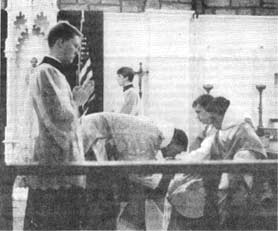
During the Solemn High Mass for the Feast of the Assumption, Father Basil blesses subdeacon Brother Cyprian at the reading of the Epistle. Father de la Tour, as deacon at the Mass, is seated next to Father Basil. Here, above the chasuble, can be seen the white hood that the Benedictine priest wears as he enters the sanctuary before Mass.
Here is the miracle of a traditional monastery rising in a world that cries out against solitude, yet has such great need of silence. The work progressed, till at last the wings enclosed a small cloister where red cedar beams and pillars from Canada support the roofed cloister walks—a cloister closed to the clamor of the world, open only to heaven.
Now, only the church and one wing remain to be built—and fifty monks are already in residence at LeBarroux!
Meanwhile, a new project has presented itself at the monks' door—to help the Benedictine Sisters build a convent. A traditional cloistered Benedictine convent, Our Lady of the Annunciation, was founded in 1979 at Uzes, a 90-minute drive from LeBarroux. With the women's deep faith and generosity, the convent has grown quickly and now numbers twenty sisters from Europe, Canada, and the U.S. The house is full and some of the sisters are living next door in donated house trailers. They too must build soon—a convent to house seventy sisters!
It is a Benedictine tradition for the sisters to locate near their brother monks in order that the monks can provide them with Benedictine priests for their chaplains and spiritual directors. The sisters have found land near Barroux and the ancient farm buildings on it are being restored for living quarters until a larger traditional convent can be built.
Thus, LeBarroux, site of the rebirth of traditional monasticism, is known all over the world; and benefactors from Europe, the Americas, Africa, Australia—through their donations—"carry a stone" to help build these houses of prayer.
The second slide show acquainted us with "The Monastic Day," beginning at 3:15 a.m. when the monks awaken for the first office of the day, Matins. The ancient custom of rising in the night comes from the exhortation of Our Lord about the watchful servant, "Blessed is that servant whom when the Lord come he shall find so doing" (Matt. 24:46). Near dawn the office of Lauds is sung; hymns of praise of the Creator echo inside the monastery walls while nature sings in the forest. It is yet early in the morning when all the monks who are priests say their private Masses in the lateral side chapels of the crypt. (The crypt, or basement, of the future church presently serves as the chapel.)
We followed the monks to breakfast and to their various chores and studies of the morning. We saw the chapter room where they gather daily to study a chapter of St. Benedict's Rule, their rule of life; and we attended the daily conventual High Mass at mid-morning. We saw the periods of study alternate with the chanting of the office—for this is the true "work of God" for the Benedictine. We entered the long refectory where the monks dine in silence while listening to spiritual reading to nourish their souls.
After the studies of the morning, we observed the manual work of the afternoon: gardening, beekeeping, caring for chickens, carpentry work, sewing of habits, baking and selling bread. We accompanied the monks in their recreation: an outing where they hike in the hills each Monday with joyous conversation and laughter, pausing to sing the Office amid the rocks and wildflowers. With the singing of Compline as the light faded in the evening sky the monastic day came to its deeply peaceful close.
Of course, there was a high-spirited question and answer period as part of the slide show. We knew that Brother Cyprian, an American, could speak English; but rumor had it that French Father Basil spoke no English. So much for rumor! Father studied six years in London and speaks English with a British accent!
The question on everyone's mind was "How do you get those hair cuts?" Father Basil says, "It's sort of like dog clippers, and we just go 'round and 'round!" We learned that the "corona" is cut fortnightly and that Brother Cyprian measures the width of the corona, which is different for each order that wears the tonsure, be they Dominicans, Franciscans, or Benedictines.
The tonsure is worn by monks who are priests or clerics (studying for the priesthood). In most religious orders when the candidate for the priesthood receives the tonsure, just a little hair is clipped from his head; but these Benedictines wear the full tonsure.
The corona, or "crown," especially represents the Crown of Thorns and union with Christ's Passion. It represents the union between the priest and Christ, reminding him that he is to be another Christ, reminding him of the sanctity required of the priest.
Lay people, having heard about the "sign language" of the monastery, were curious about it. The sign language is not a way of "getting around" the silence, but of conveying necessary messages such as "peel the potatoes" or "pass the salt" without disturbing someone else who is meditating as he works or eats in silence. One abnegation of the monastic life is that at mealtime monks do not ask for things for themselves, but rather depend on their neighbor to observe their need and ask for them. Fr. Basil shared with us a "monastery joke" about a monk who discovered a mouse in his soup. He couldn't ask the server to come and take it away, and his neighbor was unaware of his dilemma. Finally the monk with the mouse motioned to the server and signed, "Please bring my neighbor a mouse, he doesn't have one for his soup!"
Amid such banter it was difficult to tear ourselves away for lunch.
In the afternoon, pilgrims returned to McCabe for an excellent conference on prayer by Fr. DeLallo who explained that man was created to love and serve God and thereby save his soul. Father asked how can man love God without knowing Him, and how can he know Him without speaking to Him? Father explained the necessity of prayer to keep us from sin and help us persevere, and the exhortations of Our Lord, "Watch and pray that you may not enter into temptation. Pray always and never cease." Our whole life can be a prayer through the Morning Offering and the turning of all our daily actions toward God.
Father gave suggestions on how to meditate and how to deal with problems in prayer: distractions, dryness, attachment to consolations. He concluded, "Pray to God in your heart and you will grow in the spiritual life."
Till now we've not mentioned the weather during this Pilgrimage. August in Kansas is often hot and dry—but this year was cool and wet. By the time of Solemn First Vespers for the Vigil of the Assumption, the rain had stopped, but the grass was soggy, the campus paths muddy. The planned route of the outdoor procession with the Blessed Sacrament was shortened from a great circuit of campus to a dry route on the sidewalks. Campus artists had made the usual liturgical designs in flowers and sawdust on the path over which Our Eucharistic Lord would be carried.
The procession presented the great diversity of Holy Mother Church. Father de la Tour carried the Blessed Sacrament in the golden monstrance under a canopy supported by laymen of the parish. Servers—leading the way carrying the cross, candles, or incense; or flanking the procession while bearing torches—ranged in age from the very young to high school boys and seminarians. Little girls in white First Communion dresses scattered flowers over the path. Behind the Blessed Sacrament came priests, brothers, monks, sisters, and lay-people—mothers pushing baby strollers and grey-headed grandparents—all following their Eucharistic Lord and singing traditional hymns in His honor.
As we circled the front driveway and turned back toward the chapel we saw what had not been visible minutes before: heavy blue-black clouds rolling in rapidly from the northwest. There was little time to spare! We had just re-entered the chapel, Father had placed the monstrance above the altar, and the last pilgrims were getting in the door, when the clouds let loose a pounding torrent! God's timing was perfect.
In the evening after dinner and a religious film, "Come to the Stable," the "Living Rosary" was planned. The rain had stopped but the grass was too wet for the usual outdoor ceremony so, for the first time the "in case of rain" plan was used—and was most edifying.
When pilgrims had gathered in the darkened chapel the "beads" of the Rosary entered in procession—"Hail Marys" wearing blue robes and carrying blue votive candles, "Our Fathers" in white. They formed a string of beads in the outer aisles, completely encircling the pilgrims kneeling in the pews. Those representing the Crucifix and first few beads of the Rosary advanced down the center aisle. As Fr. DeLallo led the Rosary, servers went from bead to bead, lighting their candles, so that gradually the soft glow ringed the chapel—a beautiful ending to the day.
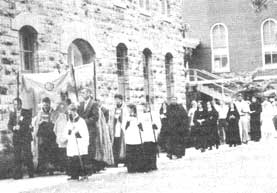
In the outdoor procession of the Blessed Sacrament were priests, monks, brothers, nuns and laypeople of all ages, following Our Blessed Lord.
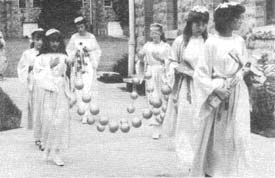
Young ladies of St. Mary's Academy carry the huge Rosary to be placed at the feet of Our Lady during the outdoor crowning of Mary on the Feast of the Assumption.
The Feast of the Assumption
The rain ceased on Our Lady's feastday, but the weather remained cloudy and cool. Father Basil was celebrant at the beautiful Solemn High Mass with Fr. de la Tour as deacon, and Brother Cyprian (who is a subdeacon) as subdeacon. Benedictine rubrics for the High Mass differ somewhat from the Roman, being similar to a Pontifical High Mass in that the celebrant remains at the side of the sanctuary during the readings and when he blesses the subdeacon and deacon at the reading of the Epistle and Gospel.
In his sermon, Fr. Basil dwelt on the theme that charity rejoices in the good we see our neighbor receive. Thus, Holy Mother Church makes us rejoice in the good God has given Our Lady. He reminded us too that Our Lady did not have the vision of God on earth; she gained merit by keeping faith, especially at the foot of the Cross where she continued to meditate with faith on what Jesus had said. We call on her help in the present situation in the Church; even if we feel we haven't anything to tell her, she likes us to speak to her, and she will draw us to the Blessed Trinity and teach us to have faith.
After Mass, Father Basil who was also recently ordained by Archbishop Lefebvre, imparted his individual "first blessings" on the pilgrims. The monks made themselves available to anyone who wanted to chat with them, particularly to ask questions concerning vocations.
Early in the afternoon, Fr. DeLallo gave his second conference, this one on the Blessed Sacrament. He showed how the Blessed Sacrament was prefigured in the Old Testament, and how Our Lord gradually revealed the doctrine of the Blessed Sacrament in the New Testament. He explained the dispositions we should have when receiving Holy Communion, how we should make our thanksgiving, and how we should have a spirit of continual thanksgiving throughout the day as we go about our ordinary duties. With proper preparation for Communion, we will grow to love Our Lord more; there is no better way to become saints than through frequent reception of Holy Communion.
Following this conference, pilgrims went to the chapel to make or renew the Total Consecration to the Blessed Virgin Mary according to St. Louis Marie de Montfort. Here, Father DeLallo explained in short the purpose of the consecration and how—as St. Louis taught— true devotion to Mary will lead us to Christ.
Then it was time for the outdoor procession to Our Lady's statue and the crowning of Mary. Everyone smiled to see the long procession of altar boys—around forty of them— from the littlest kindergarteners to senior altar boys. The sacristy cupboards must have been bare after they were all supplied with cassocks and surplices! The girls—from tiny tots to young ladies—carried flowers, the giant Rosary that would be placed at Our Lady's feet, and the crown for Our Lady.
Pilgrims sang, "O Mary, we crown thee with blossoms today," as the procession passed through their midst. Whose heart can not but be moved, and eyes moistened, when a little girl in her white First Communion dress ascends the steps to crown Our Lady—who is our Queen, who is so good to us, her children.
Brother Cyprian, a cleric in major orders, led the prayers during the crowning, singing Our Lady's Litany of Loreto in Latin as the pilgrims responded "ora pro nobis." Then the procession returned to the chapel for solemn Second Vespers and Benediction, at which the pilgrims sang with unction—how happy and blessed we are to be able to adore Our Lord in the Blessed Sacrament.
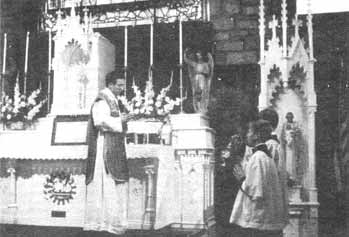
Fr. Devillers, recently ordained and assigned to St. Mary's College, celebrates the High Mass for the Vigil of the Assumption.
Swiftly now the Pilgrimage drew to a close. At the evening banquet in the cafeteria 250 were served. Referring in his brief talk to the crisis in the Church, Fr. de la Tour said that although we feel like giving up sometimes, the cause is not lost so long as true Catholic hearts are alive. Pray to Our Lady to give us the strength we need to continue the work of the Church for the glory of God and salvation of souls, for we have been created for the glory of God and to be saints.
The last event of the evening was the showing of the classic film, "Song of Bernadette." After the movie, the clouds were gone and the stars were shining. People strolled to the grotto of Our Lady, renovated for the Pilgrimage through the efforts of a parish family. The waterfall cascaded into the little fish pond and colored lights illuminated the grotto with its white gravel walks and newly-planted roses.
Thus another pilgrimage came to a close. In the words of Fr. de la Tour to the pilgrims, "God bless you and your families, and we'll see you next year!"
Pilgrimage Postscript: Benedictines Tour Southwest
For Father Basil and Brother Cyprian, the Pilgrimage was only the beginning of their trip. From St. Mary's they were taken by James S. Taylor, St. Mary's College President, on a tour of the Southwest. I turned to Mr. Taylor for information about the days that followed.
Leaving St. Mary's on the afternoon of the 15th, they drove through Oklahoma, with the monks punctually singing the Divine Office in the car. The following evening they arrived in El Paso, Texas, at Jesus and Mary Chapel of the Society of St. Pius X. There they were greeted by Father Pazat with much joy and laughter. We Americans take for granted the vast distances in our country; it was a revelation to Father Basil that in two days they had only been in three states! At El Paso, Father Basil said an evening Mass, and gave the slide show for about sixty people. The show is a double projector affair with background music, and there, at. El Paso, everything that could possibly go wrong with the slide show went wrong. Yet, at the end, the people gave a tremendous response. The mere presence of the monks and the beautiful slides had conveyed the message. Likewise, the monks were impressed by the family spirit at El Paso.
On August 17, they went on to Phoenix, where that evening they were greeted at Our Lady of Sorrows by Father Gregory Post, Mr. and Mrs. Paul and Dan Stock. The following morning they sang a High Mass, gave the slide show to a receptive audience, and received inquiries about the Oblates.
Mr. Carl Sandstedt took them sight-seeing in Phoenix, and when they stopped at St. Mary's, an old Franciscan mission, the monks were allowed to sing the Office of None in the chapel. At Sandstedt's home, Brother Cyprian "threw pots" on Mr. Sandstedt's potter's wheel.
Mr. Taylor reports that everywhere the people responded with what he calls a "great relief." They were relieved to see these happy young men dedicated, consecrated, to God. People's faces said, "This is what religion is all about." As he says, here are these young men in black habits, black—representing burial to the world, a death shroud to the old man of sin; but above the black habits are seen the smiling, peaceful and happy faces of the monks.
They traveled without incident across the desert to California where they were greeted by area traditional priests, and also by Mr. Bob Opell who is president of a traditional Mass society. These hosts took Fr. Basil and Br. Cyprian to visit groups of Catholics.
At a visit to San Juan Capistrano, the famous mission church of Fr. Junipero Serra, the early California missionary, the monks sang None, and were allowed to see many treasures of the place, including Fr. Serra's vestments.
Seeing tonsured monks in full habits, tourists stopped and stared. Everywhere they were asked, "What religion are you?" or "What order do you belong to?" But nowhere were there any cat-calls or hoots, only respect for these young monks who seem to have stepped out of the ages—timeless—into a world hungering for God, a world that somehow recognizes the monks' response to God. One observer likened the monks to "mellow marines," an apt title for these disciplined spiritual soldiers in the battle to restore Christian society to the world.
Mr. Taylor had to return to St. Mary's, but the monks stayed a few days in California, and reported that they loved the Californians. They survived trips up and down the freeways to private meetings in the Los Angeles area, and had large meetings at Oceanside and Pasadena where sixty young adults attended a vocations conference.
The Benedictines returned to St. Mary's as the school year was getting underway, and here they gave their slide show and conference to the College students on Monday, August 26. On Tuesday, Fr. Basil sang a Votive Mass of the Holy Ghost for the opening of school. Before Mass the Veni Creator was sung, and afterwards the magnificent Te Deum.
Fr. Basil and Br. Cyprian gave a day of recollection for the Academy students and slide shows for them. Students had the opportunity to hear the monks sing the Divine Office. As Fr. de la Tour pointed out, the profound bow they make as they sing the Gloria Patri reminds us of Who they are praying to: Almighty God.
On Aug. 28, the monks departed for home, leaving behind a greater understanding of their life. Let us pray for them and for more vocations, for more souls who, by their lives of prayer and sacrifice, call down God's grace into our sinful world.
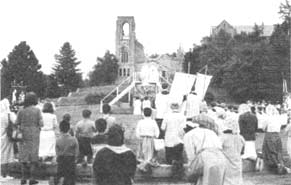
Pilgrims kneel to chant Our Lady's Litany of Loreto in Latin at the crowning of Our Lady. In the background the twelve-foot-high tapestry of Our Lady of Perpetual Help looks down from the old bell tower.
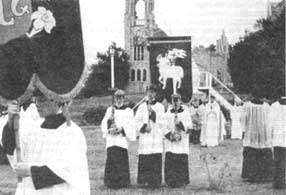
Servers bearing traditional banners lead the way as the procession returns to the chapel for Vespers of the Assumption and Benediction of the Blessed Sacrament after the outdoor crowning of Mary. Subdeacon, Brother Cyprian, in white cope, led the prayers during the crowning.
